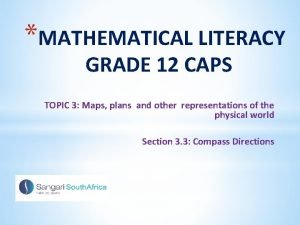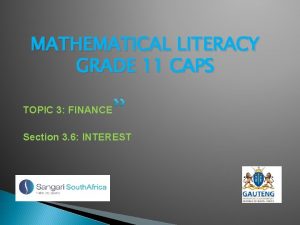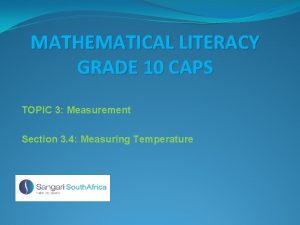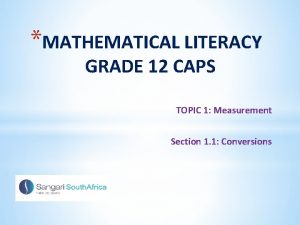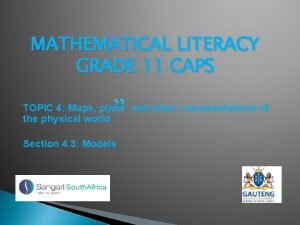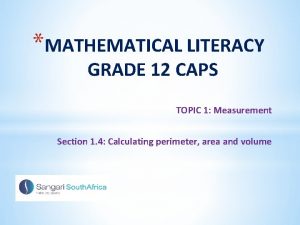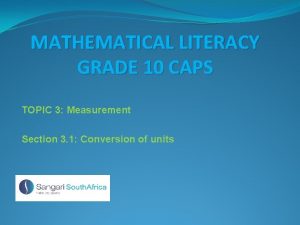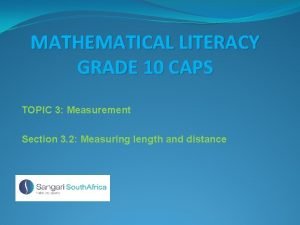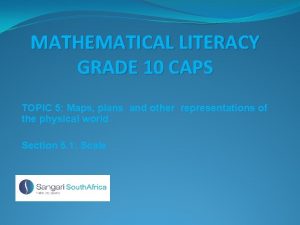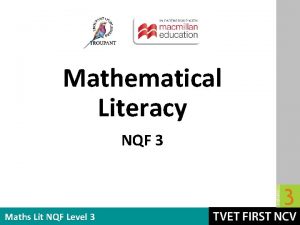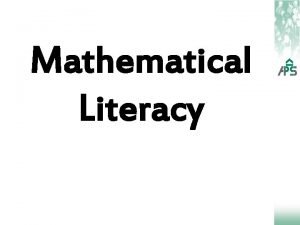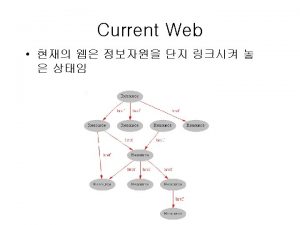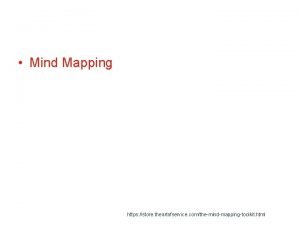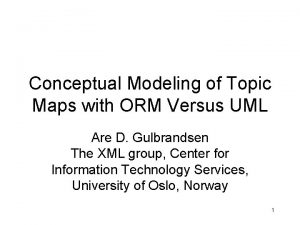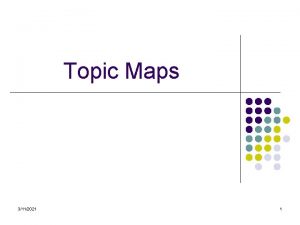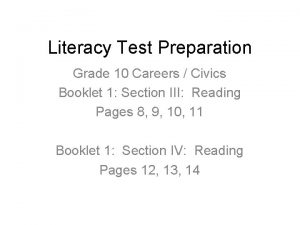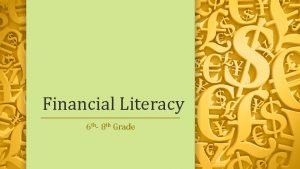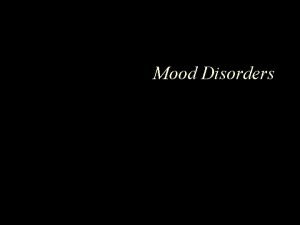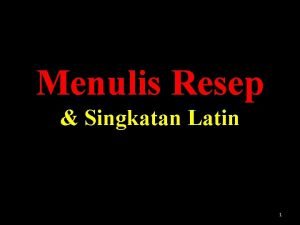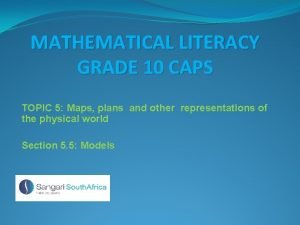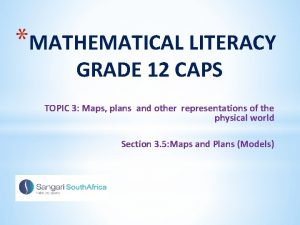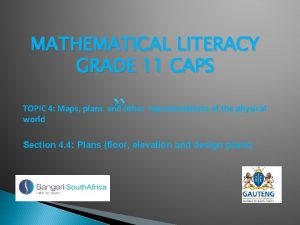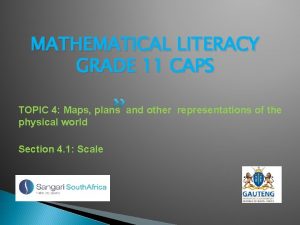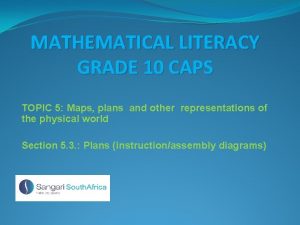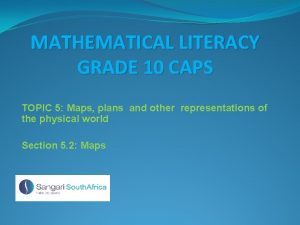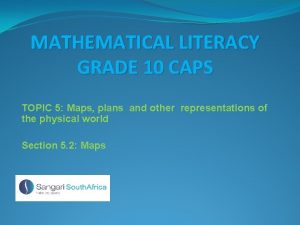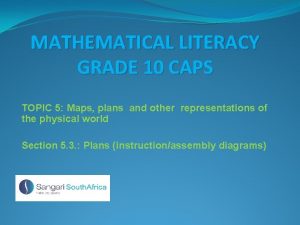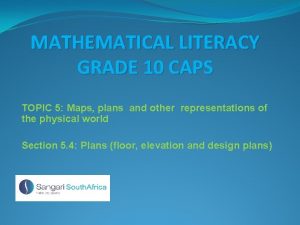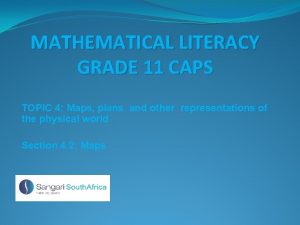MATHEMATICAL LITERACY GRADE 12 CAPS TOPIC 3 Maps







































- Slides: 39

*MATHEMATICAL LITERACY GRADE 12 CAPS TOPIC 3: Maps, plans and other representations of the physical world Section 3. 1: Scale

*Topic 3: Maps, plans and other representations of the physical world The following sections will be covered: 3. 1. Scale 3. 2. Maps 3. 3. Models 3. 4. Plans (floor, elevation and design plans)

*Section 3. 1 : Scale In Section 3. 1, learners will be able to: §Determine the scale in which a map or plan has been drawn. §Check that the scale of a map or plan is accurate by: Øthe use of bar scale to check accuracy of number scale Øthe use of number scale to determine/draw a bar scale

*Checking the accuracy of a given scale. Sometimes maps are made bigger or smaller when they are reproduced in books or photocopied. This will not affect the accuracy of a bar scale because the bar scale is a ‘picture’ and this picture will resize by the same proportions as the map when it is made bigger or smaller. However, when a map is resized then the original number scale of the map is no longer valid. This is because the original number scale specified precisely how much smaller the picture on the map was from the actual size of the land. Since the size of the map has changed, this relationship must also change. In this section you will explore different ways of checking the accuracy of a number scale of a map.

*Determining an equivalent number scale for a bar scale. Consider the bar scale shown below:

*Determining an equivalent number scale for a bar scale. Measuring on the bar scale gives that 2 cm of measured distance is equivalent to 500 m in actual distance. This can be simplified to: 2 cm = 500 m Hence, 1 cm = 250 m To convert this relationship of 1 cm = 250 m to a number scale, we need to have both values in the same units. So, the equivalent number scale for this bar scale is: 1 cm : 25 x 100 cm i. e. 1 : 2500

*Checking the accuracy of a number scale. The section of a street map on the next slide shows a number scale and a bar scale The number scale 1: 20 000 tells us that every measurement on the map is 20 000 times smaller than the distance in Pietermaritzburg. Measuring on the bar scale with a ruler tells us 2 cm is equivalent to 300 m, or 1 cm is equivalent to 150 m. We need to check whether these two scales are the same or not.

*Checking the accuracy of a number scale.

*Checking the accuracy of a number scale. We use the idea of determining an equivalent number scale for a bar scale. We found in slide 7 that the equivalent number scale for the bar scale is : 2 cm = 300 m 1 cm = 150 m Converting both values to the same units gives: 1 cm =15 000 cm So, an equivalent number scale for this map is:

*Checking the accuracy of a number scale. This means that the shown number scale of 1 : 20 000 is inaccurate. Every measurement is actually 15 000, not 20 000, times smaller. This could have been the result of resizing the map so that it is now 15 000 times smaller. The original map was bigger than this version.

*Determining the scale of a map Sometimes maps do not contain a scale. It can be useful to determine the scale to use the map to find other distances. Determining the scale of a map involves working out the relationship between a length measured on the map and the actual distance. To do this you have to know the actual distance of at least one map feature.

A segment of a strip chart is shown below. Notice that no scale is provided.

*Example: 1 To work out the scale of this map you can use the actual distance of one section of the road. For example, let’s use the fact that the section of the road from Edenburg to Trompsburg is 39 km. Step 1: Use a ruler to measure the length of the feature for which you know the actual distance. Measuring the length of the section of the N 1 between Edenburg and Trompsburg with a ruler gives a length of approximately 2. 3 cm.

*Example: 1 *Step 2: Equate the measured length to the actual distance of the feature 2. 3 cm measured length = 39 km actual distance Convert km to cm by multiplying by 100 000 cm i. e 2. 3 cm = 39 x 100 000 cm i. e 2. 3 cm = 3 900 000 cm Divide both sides by 2. 3 cm ÷ 2. 3 cm = 3 900 000 cm ÷ 2. 3 cm So the number scale of this map is 1 : 1 695 652

*Activity: 1 1. Refer back to the segment of the strip chart given in Example 1. 1. 1 Use the number scale that was determined in the example to work out the approximate actual distance (in km) of the road section from Petrusburg to Koffiefontein. 1. 2 Now explain why being able to calculate the scale of a map can be a useful skill in planning and managing a trip? 1. 3 Develop a suitable bar scale for this strip chart equivalent to the number scale.

*Activity 1: Solutions 1. 1 The distance is approximately 3. 5 cm on the map. This means that the actual distance on the ground is: = map distance x scale = 3. 5 cm x 1 695 652 = 5 934 782 cm. To convert cm to km we divide by 100 000 = 5 934 782 cm ÷ 100 000 cm = 59. 34782 km. ≈ 59. 35 km

*Activity 1: Solutions 1. 2 It helps to determine the approximate distance between two towns thus allowing you to determine if you can make the distance with the petrol in the vehicle, or if you need to stop on the route. You can also work out the approximate time of the journey. 1. 3 Any suitable answer will do here. E. g. 0 28 56 km Where each small bar measures 2 cm.

*Activity: 2

*Activity: 2 2. Consider the street map of the centre of the town of Paarl in the Western Cape, on the previous slide. 2. 1 Use a ruler to measure the distance (in cm)between the crosses at points A and B along Optenhorst road. 2. 2 Use the bar scale to work out the actual distance between A and B. 2. 3 Use the number scale to determine the actual distance between A and B.

*Activity: 2 2. 4 Explain what it means that you found different answers when using the bar scale and the number scale. 2. 5 Explain why it is the bar scale and not the number scale that gives the correct answer. 2. 6 Use the bar scale to work out a more accurate number scale of the map.

*Activity 2: Solutions 2. 1 Approximately 16. 5 cm 2. 2 Bar scale is 7. 5 cm = 600 m i. e 1 cm = 80 m Hence, actual distance = 80 m/cm x 16. 5 cm = 1320 m ÷ 1000 m = 1, 320 km ≈ 1, 3 km

*Activity 2: Solutions 2. 3 Number scale on map is: 1: 10419 Hence, 16. 5 cm represent 16. 5 cm x 10419 = 171913. 5 cm ÷ 100 cm = 1719. 135 m ≈ 1. 72 km 2. 4 This means that the map has either been reduced or enlarged in size and yet the number scale has not been changed proportionally.

*Activity 2: Solutions 2. 5 As the map reduces or enlarges, so does the bar scale. The number scale remains the same, except the writing either enlarges or reduces. 2. 6 7. 5 cm = 600 m 7. 5 cm = 60 000 cm 1 cm = 8000 cm 1: 8000

*Final Assessment Questions 1 -10

*Question 1. Look at the bar scale below. What does one centimetre represent on each line? 0 60 km (a) (b) 0 140 m

*Question 1. 1(a) A. 1 cm = 10 000 cm B. 1 cm = 100 000 cm C. 1 cm = 1000 cm 1(b) A. 1 cm = 3500 cm B. 1 cm = 35 cm C. 1 cm = 350 cm

*Question 2. Calculate the actual distance (in km) that a map distance of 29 mm represents on maps with the following scales: (a) 1: 15 000 (b)1: 150 000 2(a) A. 4, 35 km B. 0, 435 km C. 43, 5 km. 2(b) A. 4350 km B. 435 km C. 43, 5 km

* Map of South Africa (questions 3, 4 and 5 )

*Question 3 Study the map of South Africa to answer questions 3, 4 and 5. You will need a ruler with millimetre(mm) intervals to measure the lengths. Use the bar scale to estimate the distance between Kimberly and Bloemfontein. A. 150 km B. 15 km C. 1, 5 km

*Question 4. Use the bar scale to estimate the distance between Polokwane and Pretoria. A. 250 km B. 200 km C. 186 km

*Question 5. Use the number scale that is given below the bar scale to calculate the actual distances between the places in questions 3 and 4 to the nearest kilometre. (a) Bloemfontein to Kimberly A. 30 km B. 300 km C. 3000 km (b) Polokwane to Pretoria A. 390 km B. 39 km C. 3900 km

*Question 6. Use the following line scale to determine the map scale as a ratio in the form, 1 : another number. A. 1: 60 B. 1: 400 C. 1: 6000

*This picture is drawn to scale *Question 7.

*Question 7. The picture of a lady on the previous slide was drawn to scale. The actual height of the lady is 1, 68 m. Determine the scale that was used to draw the picture in the form 1: n. A. 1: 10 B. 1: 50 C. 1: 17

*Question 8. Determine the scale of the map below if the real distance between town A and town B is 48, 75 km. A. 1: 750 000 B. 1: 363806 C. 1: 150 000

*Question 9. The map on the next slide shows the route of a 4 x 4 race route. The vehicles have to pass each checkpoint in the given order to complete the race. Use the map to answer questions 9 and 10. Determine the scale of the map as a ratio. A. 1: 963855 B. 1: 100 000 C. 1: 800 000

*Race route map (Questions 9 & 10)

*Question 10. a) What is the total actual distance covered on the route to nearest km? A. 794 B. 900 km C. 678 km b) If the vehicles average at a speed of 45 km/h on this route, how long would it take them to complete the race to the nearest hour? A. 12 hours B. 15 hours C. 20 hours

*Solutions Final Assessment Questions *1 a) B 1 b) A *2 a) B 2 b) A *3 A 4 C *5 a) B 5 b) A *6 B 7 C *8 B 9 A *10 a) C 10 b) B
 Maps and scales maths lit grade 12
Maps and scales maths lit grade 12 Names of maps in mathematical literacy grade 12
Names of maps in mathematical literacy grade 12 Floor plans maths lit grade 11
Floor plans maths lit grade 11 Strip map mathematical literacy
Strip map mathematical literacy Mathematical literacy finance
Mathematical literacy finance Maths literacy grade 11 finance pdf
Maths literacy grade 11 finance pdf Calculating tariffs grade 11
Calculating tariffs grade 11 Mathematical literacy grade 10 measurements
Mathematical literacy grade 10 measurements Conversions in maths lit grade 12
Conversions in maths lit grade 12 Packaging mathematical literacy grade 12
Packaging mathematical literacy grade 12 Exchange rate maths literacy
Exchange rate maths literacy Mathematical literacy grade 12 finance and measurement
Mathematical literacy grade 12 finance and measurement Mathematical literacy grade 10 measurements
Mathematical literacy grade 10 measurements Mathematical literacy grade 10 measurements
Mathematical literacy grade 10 measurements Caps topic
Caps topic Non mathematical economics
Non mathematical economics Google map reittihaku
Google map reittihaku Types of data in maths lit
Types of data in maths lit What does rounding mean on a till slip
What does rounding mean on a till slip Difference between mathematics and mathematical literacy
Difference between mathematics and mathematical literacy Media literacy vs information literacy comparison
Media literacy vs information literacy comparison What is information in mil
What is information in mil What's
What's Cyber literacy for the digital age
Cyber literacy for the digital age Semantic web example
Semantic web example Sciplore
Sciplore Topic maps
Topic maps 3112021
3112021 Broad topic and narrow topic examples
Broad topic and narrow topic examples Tapic about internet
Tapic about internet Literacy by design grade 2
Literacy by design grade 2 Pfl math
Pfl math Grade 10 literacy test
Grade 10 literacy test Investinwhatsnext
Investinwhatsnext Visual literacy grade 10
Visual literacy grade 10 Grade 5 financial literacy
Grade 5 financial literacy Next generation personal finance standards
Next generation personal finance standards Caps saude mental
Caps saude mental Sig e caps
Sig e caps S2 dd tab 1
S2 dd tab 1

